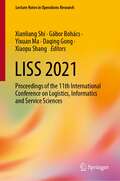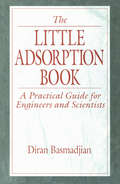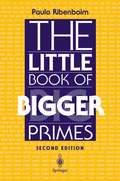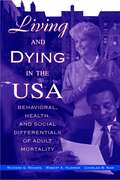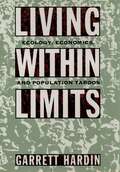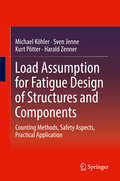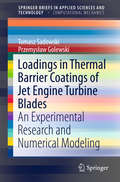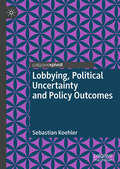- Table View
- List View
LISS 2021: Proceedings of the 11th International Conference on Logistics, Informatics and Service Sciences (Lecture Notes in Operations Research)
by Xianliang Shi Xiaopu Shang Gábor Bohács Daqing Gong Yixuan MaThis book aims to provide new research methods, theories and applications from various areas of management and engineering. In detail, the included scientific papers analyze and describe communication processes in the fields of logistics, informatics, service sciences and other related areas. The variety of the papers delivers added value for both scholars and practitioners. Information and communication technologies have been providing an effective network infrastructure and development platform for logistics and service operations. To meet the needs of consumers and to promote core competences, many institutions and firms have been developing new types of services. This proceeding focus on “AI and data driven technical and management innovation in logistics, informatics and services.” In detail, the included scientific papers analyze the latest fundamental advances in the state of the art and practice of logistics, informatics, service operations and service science. This book is the documentation of the conference “11th International Conference on Logistics, Informatics and Service Sciences,” which took place at the Shandong University. Due to the impact of COVID-19, LISS 2021 took place online as a virtual conference.
A List of Successes That Can Change the World: Essays Dedicated to Philip Wadler on the Occasion of His 60th Birthday (Lecture Notes in Computer Science #9600)
by Sam Lindley Conor McBride Phil Trinder Don SannellaThis volume is published in Honor of Philip Wadler on the occasion of his 60th birthday, and the collection of papers form a Festschrift for him. The contributions are made by some of the many who know Phil and have been influenced by him. The research papers included here represent some of the areas in which Phil has been active, and the editors thank their colleagues for agreeing to contribute to this Festschrift. We attempt to summarize Phil Wadler's scientific achievements. In addition, we describe the personal style and enthusiasm that Phil has brought to the subject.
Lit and Dark Liquidity with Lost Time Data: Interlinked Trading Venues Around The Global Financial Crisis
by T. VuorenmaaSince the 2008 financial crisis, researchers and policy makers have been looking to empirical data to distil both what happened and how a similar event can be avoided in the future. In Lit and Dark Liquidity with Lost Time Data, Vuorenmaa analyses liquidity to better understand the crux of the financial crisis. By relating liquidity to jump activity, market microstructure noise variance, and average pairwise correlation, Vuorenmaa uncovers the dynamics and ramifications behind anonymous trades made outside of public exchanges, and measures its impact on the crisis. This volume is ideal for academics, students, and practitioners alike, who are interested in investigating the role of lost time in and after the recession.
The Literature and Study of Urban and Regional Planning (Routledge Revivals)
by Brenda WhiteFirst published in 1974, The Literature and Study of Urban and Regional Planning discusses the processes of spatial planning and the range of subject knowledge which is required to contribute to it. It describes the physical forms in which the literature relating to spatial planning is usually presented and the ways in which this literature is made available in different types of organization. The author gives details of the most useful libraries whose facilities are available to students, and of the research which is being undertaken into the principal problems of planning information. The second part of the book consists of a subject bibliography, divided for ease of reference into twenty-six sections each concerned with a component part of spatial planning and containing annotated references to books, official publications, developmental plans, legislation, and other material. This book will be of interest to students of sociology and urban studies.
The Literature and Study of Urban and Regional Planning (Routledge Revivals)
by Brenda WhiteFirst published in 1974, The Literature and Study of Urban and Regional Planning discusses the processes of spatial planning and the range of subject knowledge which is required to contribute to it. It describes the physical forms in which the literature relating to spatial planning is usually presented and the ways in which this literature is made available in different types of organization. The author gives details of the most useful libraries whose facilities are available to students, and of the research which is being undertaken into the principal problems of planning information. The second part of the book consists of a subject bibliography, divided for ease of reference into twenty-six sections each concerned with a component part of spatial planning and containing annotated references to books, official publications, developmental plans, legislation, and other material. This book will be of interest to students of sociology and urban studies.
Litre to gallon conversion graph (large print)
by RnibThis page shows a line graph. There is a locator dot shown, which will be at the top left when the image is the correct way up. The Y-axis on the left of the page is litres going from 0 to 25 labelled every five litres. The X-axis at the bottom of the page is gallons going from 0 to 5 labelled every gallon. There is a grid of fine dotted lines to aid reading the graph. The data line is straight and goes diagonally up and right. Two readings are shown by a heavy dashed line. They show that 15 litres is about 3.25 gallons and that 5 gallons is about 23 litres.
Litre to gallon conversion graph (UEB contracted)
by RnibThis page shows a line graph. There is a locator dot shown, which will be at the top left when the image is the correct way up. The Y-axis on the left of the page is litres going from 0 to 25 labelled every five litres. The X-axis at the bottom of the page is gallons going from 0 to 5 labelled every gallon. There is a grid of fine dotted lines to aid reading the graph. The data line is straight and goes diagonally up and right. Two readings are shown by a heavy dashed line. They show that 15 litres is about 3.25 gallons and that 5 gallons is about 23 litres.
Litre to gallon conversion graph (UEB uncontracted)
by RnibThis page shows a line graph. There is a locator dot shown, which will be at the top left when the image is the correct way up. The Y-axis on the left of the page is litres going from 0 to 25 labelled every five litres. The X-axis at the bottom of the page is gallons going from 0 to 5 labelled every gallon. There is a grid of fine dotted lines to aid reading the graph. The data line is straight and goes diagonally up and right. Two readings are shown by a heavy dashed line. They show that 15 litres is about 3.25 gallons and that 5 gallons is about 23 litres.
The Little Adsorption Book: A Practical Guide for Engineers and Scientists
by Diran BasmadjianThis unique approach to the basic concepts of adsorption is written for students, engineers, scientists, and others who need a clear presentation of adsorption processes. Unlike other texts on this subject, which are written for the specialist and rely heavily on advanced mathematics, this unique book helps you solve everyday problems in applications of adsorption, without complex mathematics or computers.The author, a recognized expert in the field, gives you a quick introduction to the underlying physics of absorption and explains how to apply adsorption to solve analytical and design problems. Rich with practical examples and enhanced by illustrations that support the text, this refreshingly straightforward presentation helps you cut through the complexities of adsorption to find fast answers to pressing real-world questions.
The Little Book of Bigger Primes
by Paulo RibenboimThis book could have been called "Selections from the Book of Prime Number Records." However, I prefered the title which propelled you on the first place to open it, and perhaps (so I hope) to buy it! Richard K. Guy, with his winning ways, suggested the title to me, and I am grateful. But the book isn't very different from its parent. Like a bonsai, which has all the main characteristics of the full-sized tree, this little paperback should exert the same fatal attraction. I wish it to be as dangerous as the other one, in the saying of John Brillhart. I wish that you, young student, teacher or retired mathematician, engineer, computer buff, all of you who are friends of numbers, to be driven into thinking about the beautiful theory of prime numbers, with its inherent mystery. I wish you to exercise your brain and fingers-not vice-versa. But I do not wish you, specialist in number theory to look at this little book-most likely you have been eliminated from this shorter version-what a terrible feeling. But do not cry, you had your book already. This one is for those who will be taking over and should put their steps forward, mostly little, occasionally giant, to develop the science of numbers. Paulo Ribenboim Contents Preface vii Guiding the Reader xii Index of Notations xiii Introduction 1 1 How Many Prime Numbers Are There? 3 I. Euclid's Proof .. 3 11. Kummer's Proof 4 II. P6lya's Proof . .
The Little Book of Bigger Primes
by Paulo RibenboimA deep understanding of prime numbers is one of the great challenges in mathematics. In this new edition, fundamental theorems, challenging open problems, and the most recent computational records are presented in a language without secrets. The impressive wealth of material and references will make this book a favorite companion and a source of inspiration to all readers. Paulo Ribenboim is Professor Emeritus at Queen's University in Canada, Fellow of the Royal Society of Canada, and recipient of the George Pólya Award of the Mathematical Association of America. He is the author of 13 books and more than 150 research articles. From the reviews of the First Edition: Number Theory and mathematics as a whole will benefit from having such an accessible book exposing advanced material. There is no question that this book will succeed in exciting many new people to the beauty and fascination of prime numbers, and will probably bring more young people to research in these areas. (Andrew Granville, Zentralblatt)
A Little Guide for Teachers: Using Student Data (A Little Guide for Teachers)
by Richard SelfridgeStudent data can be one of the most powerful tools a teacher can use to help their students to learn. In this book, Richard Selfridge offers practical advice for teachers on how to gather useful student data in the classroom and how to use these findings effectively to enhance your teaching. The Little Guide for Teachers series is little in size but BIG on all the support and inspiration you need to navigate your day-to-day life as a teacher. Authored by experts in the field Easy to dip in-and-out of Interactive activities encourage you to write into the book and make it your own Read in an afternoon or take as long as you like with it!
A Little Guide for Teachers: Using Student Data (A Little Guide for Teachers)
by Richard SelfridgeStudent data can be one of the most powerful tools a teacher can use to help their students to learn. In this book, Richard Selfridge offers practical advice for teachers on how to gather useful student data in the classroom and how to use these findings effectively to enhance your teaching. The Little Guide for Teachers series is little in size but BIG on all the support and inspiration you need to navigate your day-to-day life as a teacher. Authored by experts in the field Easy to dip in-and-out of Interactive activities encourage you to write into the book and make it your own Read in an afternoon or take as long as you like with it!
A Little Guide for Teachers: Using Student Data (A Little Guide for Teachers)
by Richard SelfridgeStudent data can be one of the most powerful tools a teacher can use to help their students to learn. In this book, Richard Selfridge offers practical advice for teachers on how to gather useful student data in the classroom and how to use these findings effectively to enhance your teaching. The Little Guide for Teachers series is little in size but BIG on all the support and inspiration you need to navigate your day-to-day life as a teacher. Authored by experts in the field Easy to dip in-and-out of Interactive activities encourage you to write into the book and make it your own Read in an afternoon or take as long as you like with it!
Littlewood-Paley and Multiplier Theory (Ergebnisse der Mathematik und ihrer Grenzgebiete. 2. Folge #90)
by R. E. Edwards G. I. GaudryThis book is intended to be a detailed and carefully written account of various versions of the Littlewood-Paley theorem and of some of its applications, together with indications of its general significance in Fourier multiplier theory. We have striven to make the presentation self-contained and unified, and adapted primarily for use by graduate students and established mathematicians who wish to begin studies in these areas: it is certainly not intended for experts in the subject. It has been our experience, and the experience of many of our students and colleagues, that this is an area poorly served by existing books. Their accounts of the subject tend to be either ill-suited to the needs of a beginner, or fragmentary, or, in one or two instances, obscure. We hope that our book will go some way towards filling this gap in the literature. Our presentation of the Littlewood-Paley theorem proceeds along two main lines, the first relating to singular integrals on locally com pact groups, and the second to martingales. Both classical and modern versions of the theorem are dealt with, appropriate to the classical n groups IRn, ?L , Tn and to certain classes of disconnected groups. It is for the disconnected groups of Chapters 4 and 5 that we give two separate accounts of the Littlewood-Paley theorem: the first Fourier analytic, and the second probabilistic.
Liutex and Third Generation of Vortex Definition and Identification: An Invited Workshop from Chaos 2020
by Chaoqun Liu Yiqian WangThis book collects papers presented in the Invited Workshop, “Liutex and Third Generation of Vortex Definition and Identification for Turbulence,” from CHAOS2020, June 9-12, 2020, which was held online as a virtual conference. Liutex is a new physical quantity introduced by Prof. Chaoqun Liu of the University of Texas at Arlington. It is a vector and could give a unique and accurate mathematical definition for fluid rotation or vortex. The papers in this volume include some Liutex theories and many applications in hydrodynamics, aerodynamics and thermal dynamics including turbine machinery. As vortex exists everywhere in the universe, a mathematical definition of vortex or Liutex will play a critical role in scientific research. There is almost no place without vortex in fluid dynamics. As a projection, the Liutex theory will play an important role on the investigations of the vortex dynamics in hydrodynamics, aerodynamics, thermodynamics, oceanography, meteorology, metallurgy, civil engineering, astronomy, biology, etc. and to the researches of the generation, sustenance, modelling and controlling of turbulence.
Living and Dying in the USA: Behavioral, Health, and Social Differentials of Adult Mortality
by Richard G. Rogers Robert A. Hummer Charles B. NamThe simplicity of using one data set in addressing the relationship of single variables to mortality distinguishes Living and Dying in the USA from other recent investigations of mortality. The authors use the recently released National Health Interview Survey and the National Death Index to make a definitive statement about demographics and mortality. By surveying demographic and sociocultural characteristics associated with mortality, socioeconomic effects, health-related conditions, and health status, they reveal connections among several factors related to mortality chances. Easily understood and cited, their study emphasizes the statistical methods underlying their revelations and invites readers to duplicate their results.Comprehensive coverage of US adult mortality differentialsBased on a new and innovative data setIncludes factors rarely examined in related mortality researchNot only documents mortality differentials, but explores explanations for themExtensive list of references associated with each chapterConsistent, straightforward methodology used throughout aids readers in both understanding the content and in comparing results from chapter to chapter
Living Standards Analytics: Development through the Lens of Household Survey Data (Statistics for Social and Behavioral Sciences)
by Dominique Haughton Jonathan HaughtonThe purpose of this book is to introduce, discuss, illustrate, and evaluate the colorful palette of analytical techniques that can be applied to the analysis of household survey data, with an emphasis on the innovations of the past decade or so.Most of the chapters begin by introducing a methodological or policy problem, to motivate the subsequent discussion of relevant methods. They then summarize the relevant techniques, and draw on examples – many of them from the authors’ own work – and aim to convey a sense of the potential, but also the strengths and weaknesses, of those techniques. This book is meant for graduate students in statistics, economics, policy analysis, and social sciences, especially, but certainly not exclusively, those interested in the challenges of economic development in the Third World. Additionally, the book will be useful to academics and practitioners who work closely with survey data. This is a book that can serve as a reference work, to be taken down from the shelf and perused from time to time.
LMIs in Control Systems: Analysis, Design and Applications
by Guang-Ren DuanAlthough LMI has emerged as a powerful tool with applications across the major domains of systems and control, there has been a need for a textbook that provides an accessible introduction to LMIs in control systems analysis and design. Filling this need, LMIs in Control Systems: Analysis, Design and Applications focuses on the basic analysis and d
Lmsst: 24 Lectures On Elliptic Curves (PDF) (London Mathematical Society Student Texts #24)
by J. W. S. Cassels C. M. Series J. W. BruceThe study of (special cases of) elliptic curves goes back to Diophantos and Fermat, and today it is still one of the liveliest centres of research in number theory. This book, which is addressed to beginning graduate students, introduces basic theory from a contemporary viewpoint but with an eye to the historical background. The central portion deals with curves over the rationals: the Mordell-Weil finite basis theorem, points of finite order (Nagell-Lutz) etc. The treatment is structured by the local-global standpoint and culminates in the description of the Tate-Shafarevich group as the obstruction to a Hasse principle. In an introductory section the Hasse principle for conics is discussed. The book closes with sections on the theory over finite fields (the 'Riemann hypothesis for function fields') and recently developed uses of elliptic curves for factoring large integers. Prerequisites are kept to a minimum; an acquaintance with the fundamentals of Galois theory is assumed, but no knowledge either of algebraic number theory or algebraic geometry is needed. The p-adic numbers are introduced from scratch, as is the little that is needed on Galois cohomology. Many examples and exercises are included for the reader. For those new to elliptic curves, whether they are graduate students or specialists from other fields, this will be a fine introductory text.
Load Assumption for Fatigue Design of Structures and Components: Counting Methods, Safety Aspects, Practical Application
by Michael Köhler Sven Jenne Kurt Pötter Harald ZennerUnderstanding the fatigue behaviour of structural components under variable load amplitude is an essential prerequisite for safe and reliable light-weight design.For designing and dimensioning, the expected stress (load) is compared with the capacity to withstand loads (fatigue strength). In this process, the safety necessary for each particular application must be ensured. A prerequisite for ensuring the required fatigue strength is a reliable load assumption.The authors describe the transformation of the stress- and load-time functions which have been measured under operational conditions to spectra or matrices with the application of counting methods. The aspects which must be considered for ensuring a reliable load assumption for designing and dimensioning are discussed in detail. Furthermore, the theoretical background for estimating the fatigue life of structural components is explained, and the procedures are discussed for numerous applications in practice. One of the prime intentions of the authors is to provide recommendations which can be implemented in practical applications.
Loadings in Thermal Barrier Coatings of Jet Engine Turbine Blades: An Experimental Research and Numerical Modeling (SpringerBriefs in Applied Sciences and Technology)
by Tomasz Sadowski Przemysław GolewskiThis book discusses complex loadings of turbine blades and protective layer Thermal Barrier Coating (TBC), under real working airplane jet conditions. They obey both multi-axial mechanical loading and sudden temperature variation during starting and landing of the airplanes. In particular, two types of blades are analyzed: stationary and rotating, which are widely applied in turbine engines produced by airplane factories.
Lobachevsky Geometry and Modern Nonlinear Problems
by Andrey PopovThis monograph presents the basic concepts of hyperbolic Lobachevsky geometry and their possible applications to modern nonlinear applied problems in mathematics and physics, summarizing the findings of roughly the last hundred years. The central sections cover the classical building blocks of hyperbolic Lobachevsky geometry, pseudo spherical surfaces theory, net geometrical investigative techniques of nonlinear differential equations in partial derivatives, and their applications to the analysis of the physical models. As the sine-Gordon equation appears to have profound “geometrical roots” and numerous applications to modern nonlinear problems, it is treated as a universal “object” of investigation, connecting many of the problems discussed. The aim of this book is to form a general geometrical view on the different problems of modern mathematics, physics and natural science in general in the context of non-Euclidean hyperbolic geometry.
Lobbying, Political Uncertainty and Policy Outcomes
by Sebastian KoehlerThis book analyses interest group communication strategies in parliamentary political systems, and considers how political uncertainty, which emerges from the political process, shapes interest group communication strategies. It develops a formal model of lobbying in a bicameral legislature with strong party discipline, and discusses why interest groups choose public or private communication channels to influence political bargaining. The book tests its hypothesis in different policy contexts, including lobbying on major legislation in the field of labour and social policy.
